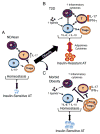The outliers become a stampede as immunometabolism reaches a tipping point
- PMID: 22889227
- PMCID: PMC3419483
- DOI: 10.1111/j.1600-065X.2012.01142.x
The outliers become a stampede as immunometabolism reaches a tipping point
Abstract
Obesity and Type 2 diabetes mellitus (T2D) are characterized by pro-inflammatory alterations in the immune system including shifts in leukocyte subset differentiation and in cytokine/chemokine balance. The chronic, low-grade inflammation resulting largely from changes in T-cell, B-cell, and myeloid compartments promotes and/or exacerbates insulin resistance (IR) that, together with pancreatic islet failure, defines T2D. Animal model studies show that interruption of immune cell-mediated inflammation by any one of several methods almost invariably results in the prevention or delay of obesity and/or IR. However, anti-inflammatory therapies have had a modest impact on established T2D in clinical trials. These seemingly contradictory results indicate that a more comprehensive understanding of human IR/T2D-associated immune cell function is needed to leverage animal studies into clinical treatments. Important outstanding analyses include identifying potential immunological checkpoints in disease etiology, detailing immune cell/adipose tissue cross-talk, and defining strengths/weaknesses of model organism studies to determine whether we can harness the promising new field of immunometabolism to curb the global obesity and T2D epidemics.
© 2012 John Wiley & Sons A/S.
Conflict of interest statement
The authors have no conflicts of interest.
Figures


Similar articles
-
B cells promote inflammation in obesity and type 2 diabetes through regulation of T-cell function and an inflammatory cytokine profile.Proc Natl Acad Sci U S A. 2013 Mar 26;110(13):5133-8. doi: 10.1073/pnas.1215840110. Epub 2013 Mar 11. Proc Natl Acad Sci U S A. 2013. PMID: 23479618 Free PMC article. Clinical Trial.
-
State of the union between metabolism and the immune system in type 2 diabetes.Genes Immun. 2011 Jun;12(4):239-50. doi: 10.1038/gene.2011.14. Epub 2011 Mar 10. Genes Immun. 2011. PMID: 21390053 Free PMC article. Review.
-
Lymphocyte roles in metabolic dysfunction: of men and mice.Trends Endocrinol Metab. 2015 Feb;26(2):91-100. doi: 10.1016/j.tem.2014.12.001. Epub 2015 Jan 5. Trends Endocrinol Metab. 2015. PMID: 25573740 Free PMC article. Review.
-
Adipose tissue inflammation in the pathogenesis of type 2 diabetes.Curr Diab Rep. 2015 Nov;15(11):92. doi: 10.1007/s11892-015-0670-x. Curr Diab Rep. 2015. PMID: 26374569 Review.
-
The "Big Bang" in obese fat: Events initiating obesity-induced adipose tissue inflammation.Eur J Immunol. 2015 Sep;45(9):2446-56. doi: 10.1002/eji.201545502. Epub 2015 Aug 19. Eur J Immunol. 2015. PMID: 26220361 Review.
Cited by
-
B cells promote inflammation in obesity and type 2 diabetes through regulation of T-cell function and an inflammatory cytokine profile.Proc Natl Acad Sci U S A. 2013 Mar 26;110(13):5133-8. doi: 10.1073/pnas.1215840110. Epub 2013 Mar 11. Proc Natl Acad Sci U S A. 2013. PMID: 23479618 Free PMC article. Clinical Trial.
-
The Bidirectional Relationship between Metabolism and Immune Responses.Discoveries (Craiova). 2013;1(1):e6. doi: 10.15190/d.2013.6. Discoveries (Craiova). 2013. PMID: 26366435 Free PMC article.
-
Meal rich in carbohydrate, but not protein or fat, reveals adverse immunometabolic responses associated with obesity.Nutr J. 2016 Dec 1;15(1):100. doi: 10.1186/s12937-016-0219-0. Nutr J. 2016. PMID: 27903298 Free PMC article. Clinical Trial.
-
Associations of Circulating Lymphocyte Subpopulations with Type 2 Diabetes: Cross-Sectional Results from the Multi-Ethnic Study of Atherosclerosis (MESA).PLoS One. 2015 Oct 12;10(10):e0139962. doi: 10.1371/journal.pone.0139962. eCollection 2015. PLoS One. 2015. PMID: 26458065 Free PMC article.
-
Identification of Potential Biomarkers of Type 2 Diabetes Mellitus-Related Immune Infiltration Using Weighted Gene Coexpression Network Analysis.Biomed Res Int. 2022 Feb 9;2022:9920744. doi: 10.1155/2022/9920744. eCollection 2022. Biomed Res Int. 2022. PMID: 35187175 Free PMC article.
References
-
- Hotamisligil GS, Shargill NS, Spiegelman BM. Adipose expression of tumor necrosis factor-alpha: direct role in obesity-linked insulin resistance. Science. 1993;259:87–91. - PubMed
-
- Kristiansen OP, Mandrup-Poulsen T. Interleukin-6 and diabetes: the good, the bad, or the indifferent? Diabetes. 2005;54 (Suppl):S114–124. - PubMed
-
- Spranger J, et al. Inflammatory cytokines and the risk to develop type 2 diabetes: results of the prospective population-based European Prospective Investigation into Cancer and Nutrition (EPIC)-Potsdam Study. Diabetes. 2003;52:812–817. - PubMed
-
- Thorand B, et al. Elevated levels of interleukin-18 predict the development of type 2 diabetes: results from the MONICA/KORA Augsburg Study, 1984–2002. Diabetes. 2005;54:29322–29328. - PubMed
-
- Lee SH, Lee TW, Ihm CG, Kim MJ, Woo JT, Chung JH. Genetics of diabetic nephropathy in type 2 DM: candidate gene analysis for the pathogenic role of inflammation. Nephrology. 2005;10(Suppl):S32–S36. - PubMed
Publication types
MeSH terms
Grants and funding
LinkOut - more resources
Full Text Sources
Medical

